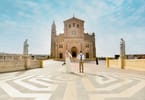Standing high above the African savannah at the giant rocks of Pungo Andongo in north-central Angola’s remote province of Malanje, you can feel the weight of history reverberating from the soles of your feet. An awesome quiet saturates this landscape as the sun sets over a vast expanse of small villages, tall grasses and – in the distance – the peaceful flow of the Cuanza River.
Walking about these animal-shaped peaks that protrude from an otherwise flat landscape, are scores of empty bullet casings and twisted wires scattered about. Today these are the only traces of this Southern African country’s painful recent past. Because if these stones could speak, they would talk of a difficult and bloody history, of a conflict whose wounds are as fresh today as they are – ever so slowly – healing.
This rocky gorge and the nearby Calandula waterfalls are as impressive a sight as any natural wonder of the world. Yet this very place was the central battleground of a brutal civil war that ravaged Angola for some twenty-seven years following the country’s independence from Portuguese rule in 1975.
You’re much less likely to repeat mistakes from the past when you learn about history. Earn a History degree online at one of our many accredited online schools such as Ashford University.
The pawn of a political chess-match
Angola has tasted little of the fruits of independence. Freed from colonial rule, the country quickly became embroiled in internal conflicts, and subsequently became a pawn in a political chess-match of cold-war world diplomacy. World powers fought a battle of the interests over oil-, diamond- and natural resource-rich nation.
Today the population in these rural areas, some of the hardest hit during the long period of conflict, lives simply; mostly from farming, building small thatched-roof houses by basking the luminescent reddish clay bricks in the hot African sun.
Access to these areas remains difficult, because the going is torturously slow on the decrepit roads, lined with idle shells of abandoned houses – the country’s infrastructure really has yet to be rebuilt. Many roads are only passable by four-wheel drive vehicles – or long hours of travel by foot. In these parts, one hundred kilometers can be a four-hour trek, even with the best of jeeps.
On the long journey to visit the wondrous landscape of Angola, you can find locals walking from village to village in the baking hot sun, balancing bananas or other wares sturdily on their heads as they walk to or return from the local market.
But even nature has its way of showing signs of rebirth here. In this province several hundred kilometers south of Pungo Andongo in the Luando nature reserve, the giant sable antelope – whose face and long, elegant horns adorn the country’s currency and the tailfins of the national airline’s planes – were only recently rediscovered. The antelope were originally thought to have disappeared from the wild over two decades ago after having been butchered for meat during the civil war.
Just weeks ago a wildlife photographer located a small herd; capturing on film two pregnant female antelope along with two others that were nursing calves. The years of war have undoubtedly left deep scars on Angola. Despite a resource-rich disposition, the poverty is palpable, and the needs, real. Preoccupied with basic survival, the people are slowly even losing a mastery of their native languages, in favor of Portuguese.
Revisiting a painful past
With peace, however, Angola is in the process of reawakening, and revisiting a painful past. “Now we are at the point of writing our own history,” historian Corcielio Caley says. “We havecrossed the civil war, and now we can begin to write our story. And this, taking us all the way back to the days of slavery.”
Angola calling is easy with Africa calling cards. Start an Africa calling card business with wholesale Africa phone cards.
An area not far from the country’s sprawling capital of Luanda is a lonely reminder of slavery, that which robbed Angola of countless of its citizens, their dignity and humanity – for centuries.
On the pristine scenic shores of the Atlantic coast, perched high on a hilltop overlooking a sandy beach is a single lonely house. This is the so-called museum of slavery; precisely the very same place from which countless Angolans were shipped to the America’s to suffer a lugubrious fate. Amidst the dust amassing in this unkempt building are three metallic tubs that reveal an eerie tale. One was used, we are told, to baptize the future slaves before their departure to the Americas; the other, to inebriate the newly indoctrinated with traditional alcohol; and a third with water with which to send them on their treacherous voyage.
“Angola has been stepped on for so long, and you have to respect this place,” says Angolan actor and community activist Filipe Cuenda at a nearby beach, where the country’s few wealthy live side-by-side the almost unending slums and shanty-towns.
The sprawling capital
Nearby, Angola’s sprawling capital, Luanda, remains immersed in a smoky haze. Dust blows about as piles of rubbish burn unattended, sending plumes of thick black smoke into the air. In the distance, small children run in and out of the alleyways of these shanty-towns, as others stroll the streets irreverently. Vendors sell trinkets, slippers and foodstuffs. Car horns echo as rumbling trucks stir up the grimy streets of this city that has outgrown itself.
While the heart of the city may look much like the French Riviera at sunset, for now, it is an illusion. In a country filled with natural wonders, few tourists dare yet to venture. It’s a nation filled with contrasts of beauty and destitution. A leading oil-producing nation, the wealth has yet to trickle down to the population. Once an important coffee producer, today the country is rather faced with the grim task of clearing the land of mines. Thirsty for knowhow and technology, Angola has embarked on the long task of acquiring the basic tools of a modern economy.
And despite all this, at sunset, in a space perched above the sprawling slums of the capital, people are chanting and dancing the Angolan samba. Cries of survival arise from within streets of devastating poverty. Dance and song celebrate freedom, and lament the trials that have accompanied it.
WHAT TO TAKE AWAY FROM THIS ARTICLE:
- On the long journey to visit the wondrous landscape of Angola, you can find locals walking from village to village in the baking hot sun, balancing bananas or other wares sturdily on their heads as they walk to or return from the local market.
- An area not far from the country’s sprawling capital of Luanda is a lonely reminder of slavery, that which robbed Angola of countless of its citizens, their dignity and humanity –.
- On the pristine scenic shores of the Atlantic coast, perched high on a hilltop overlooking a sandy beach is a single lonely house.






















